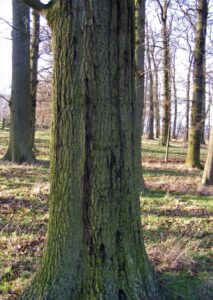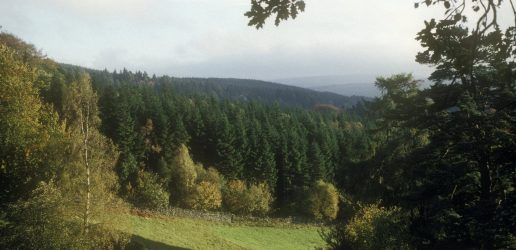Acute Oak Decline (AOD) is a complex disease of native oak trees in Britain. It is associated with several bacterial species and the native oak jewel beetle, Agrilus biguttatus. Now a newly published paper in the Proceedings of The Royal Society B, reveals the latest AOD research results from a collaboration between Bangor University and Forest Research.
The research, funded by Woodland Heritage, investigates the genetic mechanisms and enzymes used by the bacteria to cause the rotting and bleeding of oak stem tissues – the major symptom of AOD. The interactions between oak trees, the Agrilus biguttatus beetle and the bacteria were investigated to understand how they lead to the symptoms we see in trees affected by AOD.

The research found that when bacteria and beetle larvae associated with AOD were used to infect oak logs, there was a significant increase in the variety and abundance of damaging genes (enzymes and toxins) expressed by the bacteria, particularly those of Brenneria goodwinii, the main bacterial cause of the stem rot.
The key bacterial species associated with AOD were also found to work together in a co-operative way in laboratory experiments, and this enhanced their ability to break down oak tissue. They also appeared to do so in oak logs tests that mimic the disease in the field.
As a natural response to pests and diseases trees counteract attack by producing defence molecules. The research showed that certain bacterial species could neutralise these, clearing the pathway for the other bacteria and the beetle to feed off the oak tissues. In logs inoculated with bacteria and beetle eggs, bacterial suppression of the tree’s defences and breakdown of live tree tissues were stimulated and enhanced by the presence of the beetle.
Although this relationship has now been shown, more work is required to understand the complex interactions that underlie AOD, and to identify at a molecular and chemical level, what the triggers are for this amplification of gene activity and where these triggers occur in nature; for example, are they only found in the beetle, are they caused by oak tree responses to the presence of the beetle itself, or possibly other micro-organisms living in or on the beetle?
The new findings bring scientists a step closer to finding evidence to prove whether involvement and interaction with the Agrilus biguttatus beetle cause the bacteria associated with AOD to become very damaging.
New research has been published which explores how to enable and encourage access to woodlands for diverse members of the public.
Forest Research has been involved in a project focusing on efforts to improve inclusivity in biosecurity practices by exploring how to integrate different knowledge systems into mainstream decision-making.

Forest Research has released the latest Accredited Official Statistics on woodland and forestry in the UK.
New research has been published which explores how to enable and encourage access to woodlands for diverse members of the public.
Forest Research has been involved in a project focusing on efforts to improve inclusivity in biosecurity practices by exploring how to integrate different knowledge systems into mainstream decision-making.

Forest Research has released the latest Accredited Official Statistics on woodland and forestry in the UK.